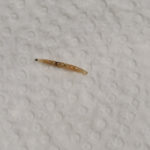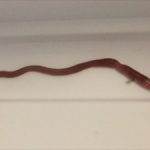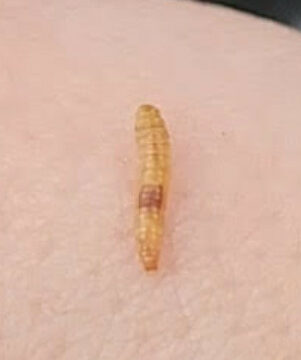A little while ago, we received a question from a reader who is seeing silver worms at night. He is wondering what the silver worms are – or, technically, what the silver worm is, as the reader seems to imply (correctly or incorrectly) that he is seeing the same worm every time it emerges – so we’ll cut to the chase: they are probably silverfish, or fishmoths, which are also commonly spelled as separate words (“silver fish” and “fish moths”). Again, all of these terms could be singular (making it fish moth, fishmoth, etc.), but this doesn’t change anything we’ll say on the matter, so we’ll switch between plural and singular forms.
Before explaining the rational for our hypothesis more thoroughly, we should fill in a few more details that the reader supplied to us. First, the silver “worms” avoid the light, which explains why the reader is seeing them at night. Second, the reader estimates that worms are about one or two inches (about 2.5 to 5 centimeters) long, which is relatively short by worm standards, but somewhat large for an insect (and silverfish are insects). Finally, the reader is from the Midwest.
It is on this information, which is actually quite a bit, given that we were sent a single-sentence description, that we base our guess that our reader found silverfish (or, again, fishmoths), which belong to the order Thysanura. As its name implies, silverfish are silver (although they can also be a bluish color) and they move around in a fish-like way. It is perhaps this later characteristic that led our reader to assume he found a worm. Silverfish do have slightly cylindrical bodies that are wingless, and when they move themselves in the style of fish, it’s not particularly surprising that someone would mistake them for worms. Indeed, people are constantly mistaking similar creatures (like various types of larvae) for worms all the time.
Why exactly do we think our reader found silverfish? First, and as we already implied, the physical features of the creature our reader found match that of the silverfish well. Silverfish are of course very often silver, and they do look like worms, although we suppose this depends on your definition of a worm. The reader also lives in the Midwest, which is a prime place to find silverfish because the creatures require a humid climate. Finally, silverfish do avoid light, which is why they are often found is places like basements and garages, and are generally most active at night. The one characteristic that doesn’t perfectly match our reader’s description is the creature’s length. Silverfish are small and only reach about 3/4 of an inch, or slightly less than two centimeters, in length when they are adults. This is shorter than what the reader describes, but not substantially so. Moreover, we have no idea what else our reader could have found besides a silverfish based on his description – it is not like there are tons of different silver, worm-like creatures that come out at night in the Midwest (as far as we know).
So, we are confident our reader found a silverfish. Before concluding it is worth adding that silverfish are considered a pest because they consume polysaccharides, which are found in a number of household items, such as paper, photos, clothing, and few different types of food. We of course have no idea if our reader is having any problems with the creature he found; considering he implied he found only one, it seems not. So, we will merely leave this as a possibility for our reader to consider, and hope our reader isn’t experiencing any silverfish-related issues.
All About Worms is always free, always reader-supported. Your tips via CashApp, Venmo, or Paypal are appreciated! Receipts will come from ISIPP Publishing.
















